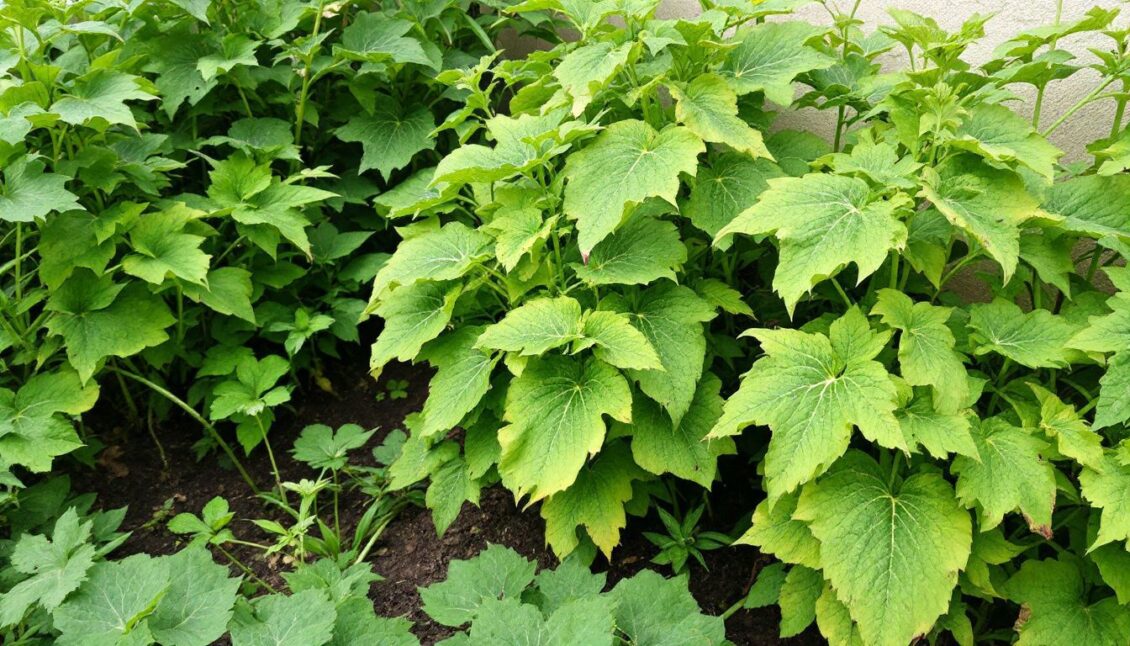Is your garden not thriving as expected? Plants need at least 14 essential nutrients to grow well. This article will explain how these nutrients, like nitrogen and phosphorus, help plants flourish.
Understanding Plant Nutrients
Plants need nutrients to grow well. These nutrients help in different ways, like forming leaves and aiding photosynthesis.
Definition of essential nutrients
Essential nutrients are chemical elements. They are vital for plant growth and development. Without them, plants cannot complete their life cycles.
Macronutrients include nitrogen (N), phosphorus (P), potassium (K), calcium (Ca), magnesium (Mg), and sulphur (S). Micronutrients include chlorine (Cl), boron (B), iron (Fe), manganese (Mn), copper (Cu), zinc (Zn), nickel (Ni) and molybdenum (Mo).
Each nutrient plays a different role in plant health.
Roles in plant growth and development
Nutrients are vital for plant growth and development. Nitrogen helps plants grow green leaves. Phosphorus transfers energy within the plant, boosting root growth. Potassium supports overall health by aiding in disease resistance and water regulation.
Secondary nutrients matter too. Calcium strengthens cell walls, crucial for rigidity and structure. Magnesium forms part of chlorophyll, helping in photosynthesis. Sulphur is key to making proteins that plants need to grow strong and healthy.
These elements work together to keep your plants thriving in both gardens and greenhouses.
Primary Plant Nutrients
Plants need the right nutrients to grow strong and healthy. Nitrogen, phosphorus, and potassium are the main nutrients they use most.
Nitrogen: Promotes green, leafy growth
Nitrogen is vital for green, leafy growth in plants. It helps form chlorophyll, which makes leaves green and aids in photosynthesis. A good nitrogen level ranges from 15 to 40 mg per gram of dry matter (DM).
Using inorganic nitrogen fertilisers boosts plant growth but requires much energy through the Haber-Bosch process. If you use too much nitrogen, plants may reach toxic levels above 50 mg per gram DM.
Choose proper amounts to keep your garden healthy and green.
Phosphorus: Crucial for energy transfer
Phosphorus plays a key role in energy transfer within plants. It helps store and move energy during photosynthesis and respiration. Phosphorus is found in every living cell, including plant tissues.
Plants need phosphorus to grow strong roots and produce fruit. You will often find inorganic phosphorus fertilisers made from rock phosphates treated with sulphuric acid. In soil, phosphorus levels should be 2-5 mg g−1 DM for optimal growth but can become toxic at levels over 10 mg g−1 DM.
Keep an eye on your soil’s pH as it affects how well plants can absorb this nutrient.
Potassium: Supports overall plant health
Potassium boosts plant health and crop yield. It helps plants use water efficiently, making them drought-resistant. Potassium also strengthens roots and stems, enhancing disease resistance.
Gardeners can add potassium fertilisers mined from marine origin ores to the soil. Using less fertiliser is possible because of genetic variation in plants for potassium acquisition.
This reduces costs and benefits the environment.
For better results, test your garden soil regularly to monitor potassium levels.
Secondary Plant Nutrients
Some nutrients are crucial for plant growth, but they are needed in smaller amounts than primary nutrients. These secondary nutrients play key roles in various processes within the plant.
Calcium: Essential for cell wall structure
Calcium keeps plant cell walls strong. It builds sturdy walls, keeping cells firm and healthy. High levels of calcium can stop other nutrients from being absorbed.
Crop plants often show calcium deficiency. This problem harms growth and leads to weak stems. Gardeners must balance soil nutrients for healthy crops and avoid adding too much calcium.
Magnesium: Central component of chlorophyll
Magnesium plays a vital role in plant health. It is a central component of chlorophyll, the green pigment in plants. Chlorophyll allows plants to convert sunlight into energy through photosynthesis.
Without enough magnesium, leaves turn yellow and the plant struggles to grow.
Plants need 2-5 mg of magnesium per gram of dry matter for healthy growth. Magnesium moves easily within the plant, helping it distribute nutrients where needed most. Keep an eye on soil pH levels; acidic soil often lacks sufficient magnesium.
Add organic fertilisers if necessary to maintain proper levels and ensure your garden thrives.
Sulphur: Necessary for protein synthesis
Sulphur (S) is vital for plants. It helps make proteins and enzymes. Plants need sulphur to grow strong. Sulphur also aids in forming amino acids, which are the building blocks of proteins.
Gardeners should ensure their soil has enough sulphur. Lack of sulphate rocks might deplete within 25-100 years, affecting plant health. Use compost or organic matter to add sulphur to your soil.
This keeps plants healthy and productive in gardens and greenhouses.
Micronutrients and Their Importance
Micronutrients, like iron and zinc, are vital for plant health. Learn why these tiny elements make a big difference.
Iron: Required for chlorophyll production
Iron is vital for chlorophyll production. Without enough iron, plants cannot produce chlorophyll, leading to yellow leaves or “chlorosis.” The ideal amount of iron for plants ranges from 50-150 milligrams per gram dry weight (DM).
Excess iron can harm plants, especially in waterlogged soils where toxic levels exceed 0.5 milligrams per gram DM. Soil testing helps you monitor and adjust iron levels to keep your plants healthy.
Use mycorrhizal fungi and compost to improve soil’s ability to supply adequate nutrients like iron.
Manganese: Assists in enzyme activation
Manganese (Mn) is crucial for plants. It activates enzymes needed for growth and development. Enzymes help in breaking down carbohydrates, important for energy.
In acid soils, high levels of Mn can harm crops. Excess Mn2+ replaces essential cations like calcium and magnesium. This displacement affects plant health negatively. Minimise this by checking soil pH regularly.
Zinc: Plays a critical role in growth hormones
Zinc helps plants make growth hormones. These hormones control how fast and tall a plant grows. A lack of zinc can cause stunted growth and smaller leaves.
Gardeners should know zinc is less mobile in plants than other minerals. This means it does not move easily from old to new leaves. So, it’s important to ensure the soil has enough zinc for proper plant health.
Use fertilisers with zinc to boost its levels in the soil.
Copper: Integral to photosynthesis
Copper (Cu) is key for photosynthesis in plants. It helps form chlorophyll, which makes leaves green and captures sunlight. Copper also aids enzymes that drive the process of photosynthesis.
Excessive copper can harm plants. High Cu levels are found in many farming soils due to human activities. Unlike some other nutrients, copper moves slowly within the plant’s phloem, making it less mobile.
Gardens and agricultural systems must balance copper for healthy crops and soil fertility.
Molybdenum: Needed for enzyme function
Molybdenum (Mo) plays a key role in plant health. It helps enzymes break down nitrogen from the soil. This aids in making protein for growth. Molybdenum is less mobile in plants, so deficiency shows up on older leaves.
Plants need only small amounts of molybdenum. Even a tiny lack can stunt growth and reduce yields. To ensure healthy plants, check soil Mo levels and use suitable fertilisers if needed.
Boron: Helps in cell wall formation
Boron is vital for cell walls in plants. It helps form and strengthen the wall, ensuring the plant’s structure stays strong. Without boron, cell walls weaken, leading to poor growth.
Boron can be toxic if too much accumulates. This often happens in sodic soils. Monitor boron levels to keep your plants healthy.
Soil Nutrient Availability
Soil conditions affect the nutrients available to plants. Soil pH and organic matter play a big role in nutrient solubility and absorption.
Factors affecting nutrient availability
Soil pH can impact nutrient solubility. For example, in very acidic or alkaline soils, minerals like iron and phosphorus become less available to plants. Soil organic matter also affects nutrient levels.
Decomposing plant residues and animal waste release essential elements back into the soil.
High mineral concentrations from fertilisation can inhibit plant growth. This often leads to reduced yields. Clay soil tends to hold onto nutrients more tightly than sandy soil does.
Leaching, where water washes away nutrients, is more common in light, sandy soils.
Impact of soil pH on nutrient solubility
Soil pH affects nutrient solubility. Acid soil can make manganese (Mn) and aluminium (Al) toxic to plants. This harms plant growth.
In alkaline soil, nutrients like iron and zinc become less available. Adjusting the soil pH helps keep essential mineral nutrients in balance for healthy plants.
Nutrient Uptake Mechanisms
Plants absorb nutrients through their roots. The root environment, including soil type and water supply, plays a key role in this process.
How plants absorb nutrients from the soil
Plants absorb nutrients through their roots. The process is essential for healthy growth and development.
- Root Hairs: Tiny root hairs increase the surface area for nutrient absorption.
- Active Transport: Specialised proteins in root cells move nutrients into the plant using energy.
- Diffusion: Nutrients pass from high to low concentration areas without energy.
- Root Environment: A moist environment helps nutrients dissolve and move easily.
- Soil pH: Correct soil pH ensures nutrients remain available for absorption.
- Symbiotic Relationships: Plants form partnerships with fungi to access more nutrients.
- Chelation: Cytotoxic cations, toxic elements, are bound by chelation to protect the plant during transport.
Root hairs and transport proteins play a key role in this process, leading to healthier crop production for gardeners and greenhouse owners.
The role of root environment in nutrient uptake
Root environments greatly affect nutrient uptake. High soil mineral concentrations stop root elongation, reducing nutrient absorption. Bad root systems can impair plant health and slow growth.
Waterlogged soils create iron (Fe) and manganese (Mn) toxicities. This harms roots and limits the intake of essential nutrients like nitrogen, phosphorus, and potassium. Proper drainage prevents these issues in gardens and greenhouses.
Nutrients in Greenhouses
Greenhouse plants need the right nutrients for strong growth. Controlled environments often demand special fertilisation to meet these needs.
Special requirements for nutrients in Greenhouse
Greenhouse plants need a balanced supply of at least 14 mineral elements. This includes primary macronutrients like nitrogen, phosphorus, and potassium. These nutrients help in promoting growth, energy transfer, and overall plant health.
Using fertilisers is crucial in greenhouses to provide these essential nutrients. Sustainable fertiliser management enhances nutrient availability and minimises environmental impacts.
Plants absorb nutrients better with mycorrhizal fungi. Genetic variation in crops can also affect how well they take up nutrients and grow efficiently.
Addressing Nutrient Deficiencies
Identify nutrient problems early to keep your plants healthy and thriving.
Identifying symptoms of nutrient deficiency
Plants often suffer from nutrient deficiencies that affect their health and growth. Identifying these issues early can save your garden.
- Nitrogen Deficiency: Leads to stunted growth and yellowing of older leaves.
- Phosphorus Deficiency: Causes dark green or purplish leaves and poor root development.
- Potassium Deficiency: Results in yellowing of leaf margins and leaf curling.
- Calcium Deficiency: Exhibits deformed new growth and blossom end rot on fruits.
- Magnesium Deficiency: Causes interveinal chlorosis, especially in older leaves.
- Sulphur Deficiency: Displays uniform yellowing of younger leaves first.
- Iron Deficiency: Shows as interveinal chlorosis, particularly on young leaves.
- Manganese Toxicity: Presents as interveinal chlorosis, mainly in young foliage.
- Boron Deficiency: Leads to deformation of new growth and blossom drop.
- Zinc Deficiency: Results in small, distorted leaves with shortened internodes.
- Copper Deficiency: Causes wilting, pale green leaves, and reduced flowering.
- Molybdenum Deficiency: Shows as stunted growth with distorted, pale green leaves.
Spotting these symptoms ensures timely intervention for a healthier garden.
Strategies for correcting imbalances
Nutrient imbalances can harm plants. Correcting these issues ensures healthy growth.
- Soil Testing
- Test soil every 2-3 years.
- Identify deficient nutrients and excesses.
- Use of Organic Fertilisers
- Compost provides balanced nutrients.
- Manure improves nitrogen levels.
- Foliar Feeding
- Spray nutrient solutions directly on leaves.
- Quick fix for immediate problems.
- Adjust Soil pH
- Use lime to raise pH if soil is too acidic.
- Apply sulphur to lower pH if alkaline.
- Hydroponics
- Control nutrient supply in water culture systems.
- Monitor and adjust regularly for balance.
- Crop Rotation
- Grow different crops each season.
- Prevent nutrient depletion by varying plant types.
- Add Specific Nutrients
- Apply nitrogen-rich fertilisers for leafy greens.
- Use phosphorus fertilisers for root crops like onions.
- Mulching
- Maintain soil moisture with organic mulch.
- Help nutrient absorption and reduce erosion.
- Use Legumes
- Plant legumes to fix atmospheric nitrogen in the soil.
- Beans, peas, and clover are good choices.
- Identify Visual Symptoms
- Identify yellow leaves mean nitrogen deficiency.
- Look out for purple leaves indicating phosphorus shortage.
- Brown leaf edges show potassium deficiency.
Correcting these imbalances supports healthy plants and a fruitful garden or greenhouse.
Advanced Plant Nutrition Techniques
Fertilisers boost nutrient availability in soil. They add essential elements like nitrogen, phosphorus, and potassium. These nutrients help plants grow strong and healthy.
Minerals from fertilisers can increase in concentration within edible portions of the plant. This benefits human health by providing more vitamins and minerals. However, using too much fertiliser can harm the environment.
Overuse may lead to water pollution and soil erosion.
Applying fertilisers correctly is crucial for successful planting seasons. Use them wisely to avoid harmful effects on nature while ensuring robust plant growth and development.
The use of hydroponics in controlled nutrient management
Hydroponics allows plants to grow without soil. Nutrients come from water mixed with essential minerals. Gardeners can control the exact amount of nutrients like nitrogen, phosphorus, and potassium.
This method improves plant health and yields. It is ideal for areas with poor mineral soils as it ensures plants get all they need. Hydroponics also boosts the nutrient content in crops by increasing mineral concentrations.
Plant Nutrition for Sustainable Agriculture
Good plant nutrition helps farms grow more food and keep the soil healthy. Read more to learn how!
Improving crop productivity and sustainability
Improve crop productivity by using the right fertilisers. Research shows that adding nitrogen, phosphorus, and potassium can boost growth and health. These nutrients help plants grow strong roots and produce more fruit.
Sustainability is key in modern agriculture. Use organic matter like compost to enrich soil. Rotate crops to prevent nutrient depletion. This improves yield and maintains soil health over time.
Enhancing nutritional quality of food crops for human health
Two-thirds of the global population risks a mineral deficiency, especially iron (Fe) and zinc (Zn). Adding these nutrients to crops can help. Gardeners can use fertilisers that contain Fe and Zn.
Use soil tests to check nutrient levels. Choose genotypes known for higher nutritional content.
In greenhouses, manage nutrients closely. Hydroponics offers precise control over nutrient delivery. This method helps plants absorb essential minerals effectively. Employing these techniques ensures healthier food crops with better nutrition for consumers.








Leave a Reply
View Comments